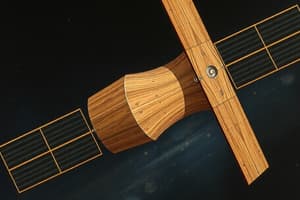Podcast
Questions and Answers
What is the primary environmental concern that LignoSat aims to address by using wood instead of aluminum in satellites?
What is the primary environmental concern that LignoSat aims to address by using wood instead of aluminum in satellites?
- The increased risk of satellite collisions due to the lighter weight of wooden satellites.
- The difficulty of recycling aluminum components from decommissioned satellites.
- The depletion of forest resources on Earth.
- The potential damage to the ozone layer from aluminum oxide particles released during satellite burn-up. (correct)
Why did the researchers choose magnolia wood for the LignoSat satellite?
Why did the researchers choose magnolia wood for the LignoSat satellite?
- It is the most abundant type of wood in Japan.
- It is the least expensive wood to process.
- It demonstrated superior resistance to the harsh conditions of space in preliminary tests. (correct)
- It was the only type of wood approved for use by the ISS.
What is the expected lifespan of the LignoSat satellite in Earth's orbit?
What is the expected lifespan of the LignoSat satellite in Earth's orbit?
- 6 months (correct)
- 1 month
- 5 years
- 1 year
Besides reducing space junk, what is another potential long-term benefit envisioned by researchers for using wood in space applications?
Besides reducing space junk, what is another potential long-term benefit envisioned by researchers for using wood in space applications?
What is the primary purpose of the LignoSat mission?
What is the primary purpose of the LignoSat mission?
How does the environmental impact of a wooden satellite burning up in Earth's atmosphere differ from that of a traditional aluminum satellite?
How does the environmental impact of a wooden satellite burning up in Earth's atmosphere differ from that of a traditional aluminum satellite?
What was the name of the collaborative project between Kyoto University and Sumitomo Forestry that led to the creation of LignoSat?
What was the name of the collaborative project between Kyoto University and Sumitomo Forestry that led to the creation of LignoSat?
Before launching the LignoSat, what preliminary step did the researchers take to assess the suitability of wood for space?
Before launching the LignoSat, what preliminary step did the researchers take to assess the suitability of wood for space?
Flashcards
LignoSat
LignoSat
World's first satellite made primarily of wood.
LignoSat Project Team
LignoSat Project Team
Kyoto University and Sumitomo Forestry.
LignoSat Mission
LignoSat Mission
To determine if wood can withstand the harsh conditions of space.
Benefit of Wooden Satellites
Benefit of Wooden Satellites
Signup and view all the flashcards
Harmful byproduct of burning satellites
Harmful byproduct of burning satellites
Signup and view all the flashcards
Byproducts of burning wooden satellites
Byproducts of burning wooden satellites
Signup and view all the flashcards
Type of wood used for LignoSat
Type of wood used for LignoSat
Signup and view all the flashcards
Future Use of Wood in Space
Future Use of Wood in Space
Signup and view all the flashcards
Study Notes
- LignoSat, the first satellite constructed primarily from wood, arrived at the International Space Station (ISS) on November 5, 2024, via a SpaceX cargo capsule.
- LignoSat, named after the Latin term for "wood", will be launched from the ISS into Earth's orbit later in November.
- LignoSat's mission is to assess wood's durability in the severe conditions of space.
- A successful LignoSat mission could lead to more environmentally friendly spacecraft designs.
The LignoSat Space Wood Project
- This is a collaborative effort between Kyoto University and Sumitomo Forestry in Japan.
- A panel with three different wood samples was sent to the ISS in 2022 and exposed to space for ten months.
- Wood from magnolia trees was selected for the satellite after analyzing the 2022 experiment results.
- Professor Koji Murata of Kyoto University noted the novelty of using wood in rocket science, as engineers typically view it as outdated for advanced technology.
Reducing Space Junk
- The primary goal of the wooden satellite is to decrease space junk.
- Current satellites are mainly aluminum, which releases aluminum oxide particles upon burning up in Earth's atmosphere, potentially harming the ozone layer.
- Wooden satellites, producing only water and carbon dioxide when burned, may mitigate this issue.
- Takao Doi, an aerospace engineer at Kyoto University, explains that burning satellites create alumina particles that linger in the upper atmosphere for years, impacting Earth's environment.
Future Implications
- Researchers envision growing trees on the Moon and Mars in the future.
- Successful testing of LignoSat would confirm wood's ability to endure harsh space environments.
- Doi suggests timber, a self-producible material, could enable building homes and living and working in space indefinitely.
- LignoSat will orbit Earth for six months, collecting data before its atmospheric burn-up.
- Professor Murata and his team plan to use LignoSat's data to develop larger, more sophisticated wooden satellites and devices.
Studying That Suits You
Use AI to generate personalized quizzes and flashcards to suit your learning preferences.





